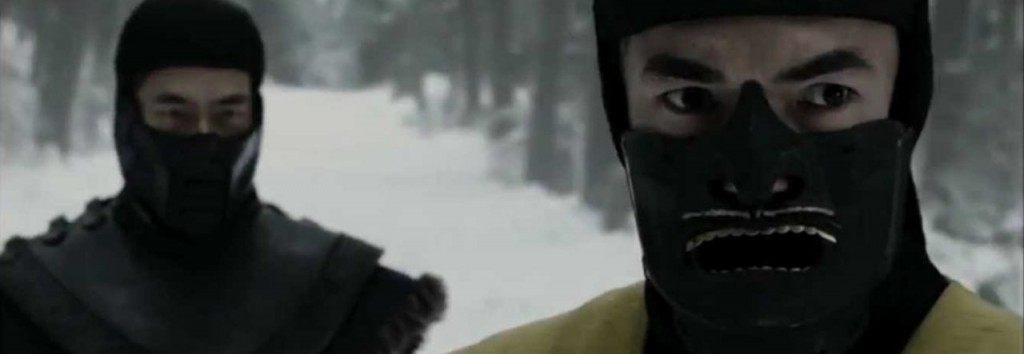James completes his look at the Mortal Kombat franchise, with a look at how its legacy is continuing.
As I discussed in Part 1, trends in entertainment (like everything else) are cyclical. In Part 2, I talked about how Mortal Kombat had its heyday and while not disappearing, became significantly less relevant and appreciated than it used to be. In this, my third and final part, I will combine those two ideas and explain that Mortal Kombat flew under the radar for a while but is now primed to come back. In fact, it has already started.
Mortal Kombat games didn’t stopped being made after its golden age, they just ceased to be culturally relevant. Serious gamers were aware of the subsequent releases, but to the average person, the titles between and including 1998’s Mortal Kombat 4 and 2007’s Mortal Kombat: Armageddon were largely unknown. And for most people who did know about them saw them as mere cash grabs, attempts to milk every last dollar from a burnt-out franchise. But the franchise still held a spot in the heart of many gamers who would be happy to get behind it again if only it could provide something interesting for the modern gamer.
This started to happen in 2008 with Mortal Kombat vs. DC Universe, in which the worlds of Mortal Kombat and DC Comics collide and the characters that populate them can fight each other. It was mostly a typical Mortal Kombat game, with a few new features, but instead of using just MK characters, you could be Superman, Batman, The Joker and several other characters from the comics giant DC. While the video game/comic book crowd certainly has a lot of overlap, this was around the time when comic books were becoming mainstream. Since Mortal Kombat’s golden age finished, there had been a huge boom in the popularity of superheroes and it only made sense to capitalize on this. In fact, the timing couldn’t have been much better as the game came out just a few months after the release of The Dark Knight. That film was one of the biggest comic book movies of all time, one of the biggest films of the year and appealed not just to die hard film buffs and comic book fans, but judging by the box office receipts, almost everybody. The movie reminded everyone how badass Batman and The Joker could be, and this game allowed you to be both of them, a factor definitely contributing to its success. As an indication of how much the concept of the game interested people, MK vs DC became the most pre-ordered game in the history of the franchise, a great sign that this idea was used at the right time in popular culture. But it wasn’t just the notion of the game but the game itself, because when gamers got their hands on it, few seem disappointed. While the release of the game was no Mortal Monday, critics and gamers were definitely enthusiastic about it. The story was a bit far-fetched, sure, but most agreed it was executed shockingly well and the gameplay was reviewed positively. As a testament to its playability, the Xbox 360 version became the 6th most rented game of 2009. I would guess that a lot of this success had to do with the timing of the superhero craze and the incredible popularity of The Dark Knight but, to its credit, Mortal Kombat had capitalized on this well, and as a result, the franchise was starting to regain momentum.
A major part of the superhero movie craze of that time was the concept of the reboot and just as the game utilized characters from the latest trend, the next step forward for Mortal Kombat on film would utilize the related notion of starting things over. On June 8th, 2010, director Kevin Tancharoen uploaded this video, titled Mortal Kombat: Rebirth, to YouTube.
The video was made as a ‘proof of concept’ to Warner Bros, which is sort of like a pitch but a much bigger one, which is meant to say, in film terms, “Yo, this is a really good idea, and not just on paper, look how sick this can be, let me make a movie.” As you can see, similar to some of the superhero movies of late, it is a more (but not entirely) realistic take on Mortal Kombat and its characters. Hilariously, Tancharoen meant to set this as a private video when posted it on YouTube, so that only certain people, presumably friends and people at Warner Bros. (who now own the rights to the franchise), could see it, but accidentally made it public when he failed to flag it properly. Call it a happy accident however because the initial reaction to the video positive, causing it to be shared all over the Internet where it was met with overwhelmingly great reviews and lots of excitement from both those who grew up with Mortal Kombat and other, regular people who barely cared about ripping the spinal cord out of Sonya Blade. Tancharoen was worried because he had not secured the rights and feared Warner Bros. would soon be knocking on his door. When they did, they brought a much better message than he was hoping for: more, please. On January 24, 2011, the public found out his experiment worked and that he had secured the official rights and an opportunity to make more Mortal Kontent. An official 10-episode web mini-series based on the short was greenlit by Warner Bros., which would soon be called Mortal Kombat: Legacy.
A few things lined up in favour of Tancharoen and his original Rebirth short film. It wasn’t just the current state of entertainment (a taste for darker, more realistic re-tellings from the beginning of the property) that allowed this Rebirth to be so successful, but the current state of technology as well. First of all, without YouTube, this movie wouldn’t have been seen by so many people, even accidentally. Without the ease with which we can share videos now, Rebirth would not have been able to gain all the public viewership and support that caught the eye of Warner Bros. (the people who owned the rights) and could let him take things further.

"So, this YouTube thing is going to help me build my dream house made entirely out of cocaine?"
Secondly, without digital technologies being as cheap as they are, there is no way Tancharoen could have done this on his own. Rebirth was financed personally in order to get the attention of Warner Bros. for $7500, a low budget even for a short film, considering the visual quality and the lower-than-A-list-but-still-recognizable actors. This is part of the technology cycles I was getting at in Part 1. When cinema started, cameras were extremely expensive but eventually the price dropped and an average person could save up, get a camera and make an amateur movie that looked to be close to the same caliber as what a studio produces. Eventually as more complicated and expensive cameras, and sound equipment, became the norm it was difficult for amateurs to keep up with the studios. Movies began to have crews numbering in the hundreds and costs in the millions. The cycle came around again recently with digital technology to the point where my friends own cameras that some commercials, TV shows and movies are filmed with. Of course they can’t make a massive film like Avatar and don’t have the budget and clout of studios to make a feature length epic but can make impressive short films that visually compare to what a low-budget major studio film looks like. Decades ago, Tancharoen could have conceptualized a reboot like Rebirth but would not be able to make it look state of the art and would have no way to distribute it. Cheaper filmmaking equipment and a free, worldwide distribution platform that is YouTube allowed him to make something that looks great and share it with everyone (whether he wanted to or not) until those who own the rights are forced to take notice or upset the fans.
Tancharoen’s web series, Mortal Kombat: Legacy, was 9 episodes long and gained even more of a following. When the first episode was released, it was YouTube’s most viewed video of the week with 5.5 million views. A day after the 5th episode video dropped, the series had more than 30 million views. The fans were clearly impressed, as were the critics. IGN called it “the most elegantly produced web series” ever and many praised its great action sequences, cinematography and realism. Tancharoen, however, was probably happiest about Warner Bros. response who, after the success of the web series and many meetings, decided to make him the director of the feature length Mortal Kombat film*. After a 14 year absence from the big screen, the owners of the franchise finally have found an approach that they like. The film is set to start shooting in March at a budget of “well under $100 million” which is still well over the $7500 Trancharoen gambled on this filmmaking experiment of his.
 *I’d like to point out this announcement was made after I started this trilogy of Mortal Kombat articles. Once again, The MacGuffin Men flex their Hollywood muscles. This means you can blame Alex when/if/when again the Arrested Development movie doesn’t happen.
*I’d like to point out this announcement was made after I started this trilogy of Mortal Kombat articles. Once again, The MacGuffin Men flex their Hollywood muscles. This means you can blame Alex when/if/when again the Arrested Development movie doesn’t happen.
Of course, Mortal Kombat started as a video game and even with the film success, that has remained the focus the property. After Mortal Kombat vs. DC Universe, another game, simply called Mortal Kombat, was released in 2011. (As it was the 9th in the series, I will refer to it as MK9 to avoid confusion with the franchise as a whole.) Perhaps taking a cue from the superhero trend that made their last game so successful, this game would be something of a reboot and altered the beginning of the entire history of the franchise. Basically, the storyline was that Raiden was about to die so he sent a message back to the version of himself from the first Mortal Kombat game and told himself to act differently. (You’d think maybe he would have used this skill earlier, perhaps to prevent him from entering a tournament essentially called Death Fight, but you know how Thunder gods are.) MK9 received some of the best review scores since its golden age and with 3 million copies sold, it is the most popular fighting game of the year. The game was praised for many of its online features, which developers wisely stated would be one of their focuses. Online play has become a crucial to the success of modern games. Some of the most popular games of the past few years, like the Call of Duty series, are played more online with friends than the campaign modes are played alone, and Mortal Kombat achieved great success when it responded to this. From playing games online I learned that despite years of people saying technology is isolating us from one another, people really do seem to prefer gaming against humans instead of computers. (I also learned a lot of 14 year olds have apparently fucked my mom but that’s a different blog post/diary entry/crying session). So many of the most popular new technologies are dedicated to socializing. iPhones, social networks, communications apps and many of the most popular new ideas are about interacting with one another. I can’t count how many times I hear the term social media in a day because humans want to interact with other humans, even if a machine is what makes it possible. Video games went from the public space of the arcade to the private area of our homes, but technology has turned those spaces public when we want them to be. When Mortal Kombat catered to that, they had one of their most financially and critical successful games in their almost 2 decades of existence. The online mode of MK9 includes something called King of the Hill mode where 8 players can watch 2 people and take turns fighting the winner, and while not fighting can use a forum to discuss moves that they see. This sounds like a function that just steals playing time but it’s really just a return to the arcade, where gamers can watch, talk, learn, argue, brag and socialize, and judging by the game’s success, this is what the people want.
Just like Mortal Kombat vs. DC Universe provided superheroes, Rebirth and Legacy provided realistic retellings, MK9 provided gamers with something popular to contemporary culture, in this case, social media. It disappeared from gaming when consoles started to look better and cost less, but now, as the cycle keeps going around, social, public, arcade style gaming is back. And considering the success of the short film and the web series, the fact there is another Mortal Kombat game in development and a high budget feature length film on the way, I think it’s safe to say Mortal Kombat is back too.




